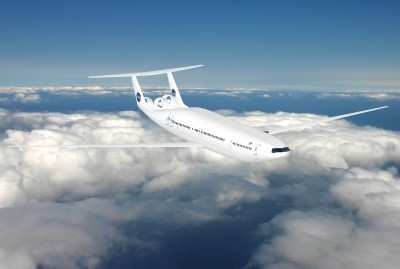Agency Awards Contracts For Additional Research Into Future
Aircraft
 Designs that may make airplanes greener and quieter for future
generations are one step closer to reality with recent NASA
contract awards.
Designs that may make airplanes greener and quieter for future
generations are one step closer to reality with recent NASA
contract awards.
Four industry and academic teams will split $16.5 million for
additional research into ideas for aircraft that could enter
service between 2030 and 2035. NASA refers to this time period as
N+3, representing technology three generations more advanced than
what is in service today. The teams studied the ideas from October
2008 to April 2010. Under the new contracts, the teams will develop
concepts and models that can be tested in computer simulations,
laboratories and wind tunnels.
The work is funded by NASA's Aeronautics Research Mission
Directorate in Washington. The agency's Fundamental Aeronautics
Program is focused on developing technology that will enable
aircraft to meet national goals for reduced fuel consumption,
emissions and noise. The program's Subsonic Fixed Wing Project
oversees the work at the agency's Glenn Research Center in
Cleveland and Langley Research Center in Virginia.
The team leaders, projects, contract amounts and periods of
performance are:
- Boeing Research & Technology, Huntington Beach, Calif.,
Subsonic Ultra Green Aircraft Research, or SUGAR, $8.8 million,
three years.
- Massachusetts Institute of Technology (MIT), Cambridge, Mass.,
Aircraft and Technology Concepts for N+3 Subsonic Transport, $4.6
million, three years.
- Cessna Aircraft Company-Cessna Citation, Wichita, Kan., Star-C2
Protective Skins-Materials & Requirements Development, $1.9
million, 27 months.
- Northrop Grumman Systems Inc., El Segundo, Calif., High Lift
Leading Edge Ground Test, $1.2 million, 14 months.
The Boeing Research & Technology award continues the work of
the SUGAR Project, which looked at truss-based wing aircraft
designs and hybrid electric engine technology. The new contract
will allow the team to start collecting higher fidelity data on its
concepts. Under the contract, the team will design, construct and
test wind tunnel mockups and computer models of the airplane. The
team also will study lightweight materials and engine concepts for
even more futuristic planes that could fly between 2040 and
2045.

Boeing Concept
The MIT team is moving forward with work on its "double bubble"
airplane design. Its concept is a dual fuselage, two partial
cylinders placed side by side, that would create a wider structure
than the traditional tube-and-wing airliner. The team will develop
the technologies identified during the first study and build a
model for testing. MIT also will explore the challenges of
high-efficiency, small-core engine technology - the idea that it is
not necessary to increase an engine's size to increase efficiency
in delivering power.

MIT Double Bubble
The Cessna Aircraft Company team will focus on airplane
structure, particularly the aircraft outer covering. Engineers are
trying to develop what some call a "magic skin" that can protect
planes against lightning, electromagnetic interference, extreme
temperatures and object impacts. The skin would heal itself if
punctured or torn and help insulate the cabin from noise. The NASA
funding will help the company develop, integrate and test the
revolutionary structural concept.
The Northrop Grumman team will test models of one very important
part of an aircraft, the leading edge of the wing. If engineers can
design a smooth edge without the current standard slats, airplanes
would be quieter and consume less fuel at cruise altitudes because
of the smoother flow of air over the wings.
 ANN's Daily Aero-Linx (04.15.24)
ANN's Daily Aero-Linx (04.15.24) Classic Aero-TV: 'No Other Options' -- The Israeli Air Force's Danny Shapira
Classic Aero-TV: 'No Other Options' -- The Israeli Air Force's Danny Shapira Aero-News: Quote of the Day (04.15.24)
Aero-News: Quote of the Day (04.15.24) Airborne 04.16.24: RV Update, Affordable Flying Expo, Diamond Lil
Airborne 04.16.24: RV Update, Affordable Flying Expo, Diamond Lil ANN's Daily Aero-Term (04.16.24): Chart Supplement US
ANN's Daily Aero-Term (04.16.24): Chart Supplement US





